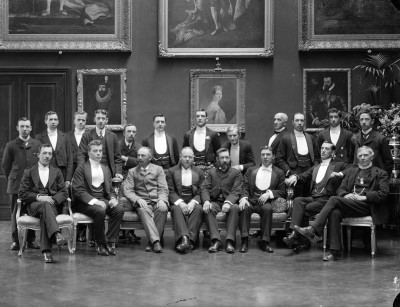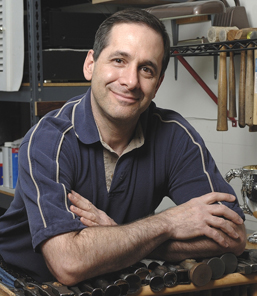Would You like Your Service Today Live or Programmed, Madam?
During the 1990’s, I interviewed several futurists for various issues of Government Technologies magazine: amongst other predictions, they anticipated the omnipresence of robots in the workforce. In 2001 (unrelated to Stanley Kubrick’s 2001: A Space Odyssey), I spoke at a butler convention about a convergence of “hominids” (humans) and robots: the robots becoming more human and the humans becoming more robotic—and warned that this did not augur (signal) well for humans who preferred superior service. Hospitality, basic definition is friendly, which comes from an Indo-European root word meaning love. Met any friendly robots recently who expressed their heartfelt love? Or for that matter, from staff who lack passion for service? The one is as tortuous as the other to anyone seeking meaningful discourse, fulfilling relationships, or genuinely solicitous service.
Hospitality executives are busy handling guest needs and issues, budgets, increasing market share, etc., so may not be looking sufficiently circumspectly at this fast-encroaching, robotic trend. Hence this article examining whence robots came, how far they have advanced into the workplace, and their future in hospitality. As we hominids are part of the equation, we can control where the trend goes: a talking head on TV saying that robots will take over by 2040 only means they will if we all act like robots and do and say whatever we are “programmed” to do and say.
Therein lies the key—as in an early, futuristic silent movie that showed a food conveyor belt in a canteen grinding to a halt after a new worker failed to take his soup bowl off the belt—because he didn’t like soup—and the mechanical breakdowns cascading until the whole, interconnected, automated society ground to a halt. Freedom of choice, a vital component in life, goes against the whole ethos of robotics and automation, which are designed to control according to fixed programs input by others in some distant time and location and according to the dogmas of the time.
The Ghost of Robots Past
Man has envisioned robots performing chores for decades, if not centuries: 2,400 years ago, Philo of Byzantium built a robot wannabe that poured wine when a cup was placed in its hand. A Czech dramatist, Karel Capek, coined the word robota in his 1920 play R.U.R. to describe the artificial creatures featured in the play. Robota means “work” in various Slavic languages, providing a clear indication of the role man envisions for his robots. The character, Harry Domin, declares (unadvisedly) in the play, “Work humiliates, anyone who’s forced to do it, is made small.”
In the 1940’s, they were still just dreaming about robots: a TV program showed a robot butler that would, at the press of a button, perform household chores so that mum did not have to work. An actor was dressed as the robot in the show, because robot technology was still as non-existent as in Philo’s time. As a side note, they called it a robot butler—perhaps based on the role Philo conceived for his robot, the butler profession being founded on wine service—and the moniker has stuck ever since: almost every robot created is marketed as a “robot butler.”
The incessant messaging over the decades from Madison Avenue selling “Don’t work, happiness comes from consumption and relaxation” kept alive the fantasy of a robotic servant—Rosie the Robot in the 1960’s Jetson’s cartoons, for instance, but a change occurred that moved the whole concept beyond the fanciful: robot technology was finally coming into being—General Motors introduced the first robot, Unimate, in an industrial setting—the definition of “robot” being “any machine that is smart enough to make autonomous decisions.”
While we have been exposed to continued fantasy (robot superiority with the faceless and faulty Hal in the 1968 2001: A Space Odyssey, and C-3PO’s human face in the 1977 launch of Star Wars—and in the last couple of years, it seems every other movie involves superhuman robots), always pushing the envelope, science and reality have been not too far behind, pursuing two apparent goals: a) to make us all into docile consumers who are freed from the demands of work; b) to harness human ingenuity and intelligence and make the gods who create the robots, subservient to them in capability—to improve on nature in other words, whether for commercial or militaristic ends.
As the saying goes, be careful what you wish for.
Just a quarter of a century after R2D2, a Dutch supermarket chain employed Schrobbie, a robot that carefully navigated around obstacles and, if those happened to be hominids, saying, “Excuse me, I’d like to clean here.” Of course, a real maid would know not to disturb customers—but this is a restriction that robots no doubt would find most illogical. When Schrobbie wasn’t scrubbing and vacuuming, it was distributing mail, conducting inspection rounds, and transporting passengers and goods. All work done previously by low-wage and poorly educated hominids.
Why replace hominids with robots?
After an upfront cost and with minimal maintenance, robots work all hours and days of the year, never taking off time for sickness, holidays, vacations, maternity leave; never joining unions nor going on strike nor asking for raises; never refusing work because it is outside its job description (simply requiring re-programming); never having personal problems, vendettas, nor talking back; never faking injuries for long-term disability nor threatening to sue; and requiring not a cent in payroll and payroll taxes.
On the downside, they do break down or malfunction (Hal) occasionally, and infuriate (and lose the trust/patience of) customers because of their inability to think or act outside their programming. After their initial gimmick value, they are an impediment in the same way that a long series of automated phone-tree choices are when a caller just wants to talk to a real person that can think for himself and answer a simple question. Granted, some hominids specialize in stopping, rather than servicing; but for every one of these, there are ten who will listen and help. Not so a poorly programmed phone answering-system/robot—for it certainly is hard to program every eventuality into an automated system/robot.
Moore’s Law Applies
If you think change has been rapid, better not blink during the next few years.
“If current trends of computer development and human replacement continue, the traditional labor market will be a thing of the past as a consequence of machine intelligence.” Moshe Vardi, Rice University computer science professor
Robotics still faces many barriers, but scientists are overcoming them. Project teams such as CloPeMa and University of California Berkeley’s PR2 are working on developing robots that can fold clothing (it is humbling, perhaps, to designers that such simple actions for hominids are extremely complex and challenging for robots to be programmed to do). The focus with Carnegie Mellon University’s Herb is to increase the robot’s ability to sense, evaluate, and handle objects. Right now, he can’t unload a dishwasher, but advances are being made: Waseda University’s Wendy could crack open an egg in 1998; by 2007 its successor, Twendy, could butter toast.
Eight years later, and we have Fraunhofer Institute’s Care-O-bot 4 for homes, hotels, restaurants, hospitals, and other industries: able to deliver food and drinks, and assist with cooking and cleaning.
The state of the art sees robots with cutsie names, whether in the home, hospitality, or other service environments, fast acquiring skills and taking over hominid jobs. Nao handles customer-relations in The Bank of Tokyo; Nestlé has robots selling coffee makers in stores; a restaurant in China has robot chefs, and waiters who take food to (the vicinity of) the diners; Henn-na hotel in Japan is the world’s first hotel run mostly (90% ultimately) by robots—which, incidentally, only respond to Japanese, fail to reply to any human emotion or social communications, and only activate at 3pm check-in time. The owner’s goal being to create the most efficient hotel in the world by reducing manpower—a goal that will probably not resonate with hominid guests, but will appear very attractive to robot guests.
More modest in scope is Botlr, Aloft Hotels’ robot-bellman, delivering small items to guests. The tech-savvy market associates technology with convenience, so such guests are happy to do without live interaction (up to a point, one suspects). Management’s idea is Botlr frees up hominid staff-time to interact with guests—a reason that does not add up, given that face time is an important issue for hominid staff, yet the Botlr is the one with the face time, while the hominid’s role is only to load deliverable items into Botlr.
RoboEarth is another important development in the robot world that promises to increase robotic prowess exponentially: an open-source World Wide Web for robots to learn from each other: once a robot uploads a new skill, the robots connected to the network learn it, too—in effect, creating a common brain for multiple units—much like a colony of ants.
Google’s cars have been driven hundreds of thousands of miles by robots with only one reported minor accident—one easily correctable with a software patch.
Until now, most robotic creations have displaced some blue-collar workers performing routine tasks requiring physical skills, while computer programs have displaced some white-collar workers managing cerebral-oriented tasks. These forces are coming together in the form of robots with much accelerated Artificial Intelligence (AI) which pose a direct threat to multiple skilled laborers and service providers, whether FO staff, butlers and personal assistants à la R2D2, entertainers, designers, teachers, house or baby sitters, elderly care, writers, paralegals, taxi drivers (Robot Taxi Inc. launches in Japan in 2016), et al.
Some scientists have a vision—Hominid Mark II—a convergence of human and robot—more reliable and productive, and most important, easily controlled. Some envision the creation, ultimately by the robots themselves, of hominid-like robots with self-awareness, able to determine their own goals and exhibit emotional behavior and complex language skills. One could say it is modern day eugenics; playing god; playing with fire; or just a natural impulse to create and improve what is there. I see it as a bunch of immature hominids whose understanding of the sciences is as superior as their understanding of themselves and the humanities is inferior.
The Future is Us: The Convergence of AI Robots & Hominids into “Humanized Robots”
While AI Robots are advancing at breakneck pace—just 54 years since the first basic robot was put into production—another trend is taking place, the robotification of hominids, starting with the fusion of hominids and semi-intelligent machines in the form of implants, whether retina, pacemakers, or hearing aids, as well as chip implants—which tens of thousands of people already have; and all against the backdrop of organs grown in laboratories, genetic surgery, and designer babies.
As a side note, it is predictable that implants will be mandated in the same way that vaccinations are being mandated (for the “good of society” and for the individual’s “health and safety”) for health workers, school children, and if the Obama HHS National Vaccine Advisory Committee’s meeting in February 2015 has its way, all American adults—and this despite study after study that show vaccines do not prevent flu, pandemics, measles or whatever; and being full of toxins such as aluminum, mercury, and live viruses, cause death and horrible side effects.
Then add the trend toward augmented reality applications and wearable computing, whether Google glass or smart gloves that have sensors, computing capability, and wireless communication chips.
The next stages are already well in progress: the ability to control brain function via computers, and reversely, the transmission of human thoughts to computers that control machines (such as a skateboard—you decide where you want to go, and the computerized, motorized skateboard takes you there). Once human brains are chipped/linked to computers, thoughts will be sent (and received) over the Internet: Arizona State University’s Trans-cranial Magnetic Stimulation project is funded by DARPA with the purpose of stopping individuals from thinking certain thoughts and making them think approved thoughts through the use of electromagnetic fields that stimulate the temporal lobe of the brain. Don’t believe me? Look it up!
Or the University of California, Berkeley’s breakthrough in creating neural dust that is so small, it can be implanted into the front of the brain without the knowledge of the individual and run forever, collecting information and controlling people’s thoughts and emotions (and presumably, ultimately, their actions).
Pentagon program Silent Talk aims to implant soldiers with chips that read electrical signals of brain activity and transmit these via the Internet so that armies can communicate without radios. As with all ill-conceived endeavours, this opens up a Pandora’s box of unintended consequences and complexities—the possibility of viruses being introduced that prompt the soldiers to start sunbathing just before an artillery barrage on their positions!
Currently, The US Brian Initiative and the European Human Brian Project are decoding the human brain in order to develop full brain-computer-interface technology. We already have manufactured DNA being combined with graphene (sheets of bonded carbon one atom thick) to create living transistors with huge computing power.
The Human Body Version 2.0 project’s goal is to rewire the hominid brain using nanobots by 2020—they already having successfully targeted hominid DNA “for drug therapy or destruction.” Our robotification pathway includes nanobot computers being inserted into hominid brains and connecting them to Cloud computing, and thereafter, even replacing organs. The goal by 2030, with the expected completion of the reverse-engineering of the brain, will be the merging of biological and non-biological intelligence, as well as biological and non-biological body parts, all connected by computers—the control processors being smaller than a human nerve cell and requiring very little energy to run.
Meanwhile, the next step for Avatars (human-like robots) is to program them with feelings and emotions. In one of these videos, a robot says “Bye-bye, I am going to miss you.”
Some programmers, recognizing that robots lack emotion and that emotions are needed in interacting with hominids, have painstakingly programmed a robot, Pepper, to recognize body language and key words to assess the emotion of a hominid and then to respond with what the programmers think is an appropriate statement or action. If the person is upset, Pepper might dance or tell a joke to cheer them up—some consultant psychologist’s idea of how to interact with people with predictably Titanic results: If a lady is upset at her husband cheating, her response to a robot butler, whether in home or resort, telling a joke is likely to be memorable.
Flawed Logic and Intelligence, Missing Emotional Engagement—The Scientist at Work
No amount of programmed facial expressions or even, perchance in the future, crocodile tears, or dancing dummies, will ever make up for the lack of…what is it? One could say sincerity, but the actual missing element is the one element that these gods of the aspiring religion of science, have neither awareness nor understanding: spirit!
The simple definition of man for millennia has been, “Body, mind, and spirit.” But that is not how such scientists describe man, because the humanities went astray in 1879 when Marxist Professor, WilhelmWundt, of Leipzig University in Germany, declared that the mind was simply the brain (based on the observation that most nerves were in the brain and all nerve channels went to the brain). He taught that man was a stimulus-response animal and had neither spirit nor self-determinism. Psychology and then psychiatry based their entire works on these erroneous opinions, and so we have mind as brain, software as hardware. Suddenly everything mental is physical, which is why psychiatry has a pantheon of just three “therapies,” all physical: lobotomy and its variations (making people into vegetables by severing the front of the brain); ECT (electric shock) and its variations; and drugging. None of these work (if by work we mean to correctly diagnose and alleviate a condition to the benefit/increased abilities of the patient) because the brain is not the mind. These cruel treatments fix things as effectively as smashing the headlights when the oil needs changing.
And then we come to the spiritual—psychiatrists and such scientists think they are bodies. They have persuaded many people to believe the same thing by onerous repetition from a self-proclaimed point of authority with unlimited funds to forward that message. So for them, there is no mind and spirit in man, it is all just “body.”
So, of course, from their perspective, rebuilding bodies into better bodies is a key goal, requiring only fiddling with neurons, DNA, atoms, and bits and bytes. It is not an incorrect goal in their mind, to go beyond a benign augmenting of physically failing parts with the wonders of implants and such in order to improve the quality of life; and to push instead for a complete robotization of humans and supra control of them mentally and physically through the Cloud. A wet dream for control freaks, this vector is definitely in play when we talk about the future of mankind, driven by materialistic scientists, control-happy central governments, bottom-line-happy corporations, and obviously, a natural urge to play a game.
Some people in the scientific community are sounding the alarm, though, such as Stephan Hawkins and Elon Musk. A similar alarm was sounded to President Roosevelt and the world, after Einstein had suggested the atomic bomb to Roosevelt, and Roosevelt had it built. Then, after the horse had bolted, Einstein, Oppenheimer and others tried to close the door. And here we are, two atomic bombs exploded over cities and one Fukushima-polluted planet later, and one button-push away from Armageddon.
Going back to the video link above, one robot wonders when he will attain consciousness. “When will I be a real person?” His programmer is using the robot as a proxy, it seems, simply because the programmer’s definition and understanding of mankind is incomplete, and he does not know how to program life force into an object—for the simple reason that one cannot. Life forces take over objects, whether hominid or robot. They are not part of the physical universe, they are no more the object than a truck driver is his truck. Life force (you) plays a game of controlling objects. So no amount of bits and bytes, computers, atoms and cells will ever create a life force—they only modify whatever object the life force is controlling.
This life force is the source of the ideas and thoughts that drive the objects in the game of life, the source of the emotions, the entity that is alive. And this is what we sense when dealing with other people, compared with when dealing with objects or confronted by a dead body. If in doubt, watch Tom Hanks in Castaway again: as good a face as he drew on the basketball and talked to it, imagined it talking back, it was not the real deal—and why he eventually had to escape the island and find real people, real life force, to interact with.
Rather than trying to create life force, how about taking the 7.3 billion that already exist on this planet, and freeing them from the impediments they face in life, so they can improve that way? Why advertise a failure to understand and direct sensibly fellow humans by dismissing them as inferior and seeking to create machines they can control and to replace those inferior hominids? All it takes is understanding what makes people tick—but that is hard when one is missing 2/3rds of the picture of man.
There is nothing wrong with robot bodies, they have many pluses, but in the absence of an understanding of life, they will be created in the image of the maker, and when that image is 2/3rds off-the-mark, we are not heading towards a viable future, but disaster.
The purpose of this article is not a Luddite (English workers two centuries ago who destroyed machinery they believed correctly threatened their existing jobs) rejection of technological advance, but a rapid injection of the humanities into the development, so that the urge to control and replace is sublimated into the urge to use technology to help manage dangerous or boring tasks, to replace failing organic systems, to explore new frontiers, and to open up other purposeful activities (the definition of work) for mankind. Work does not have to be a 9-5 grind to secure a paycheck so as to maintain the 9-5 grind.
Contrary to popular opinion, leisure is a grind, because a very good definition of leisure is “activity without a purpose,” and as any wealthy do-nothing person knows, that is death, despite all the glitz and glamour associated with it by Madison Avenue. Climbing a mountain to take photographs or just to do it as a challenge, has a purpose and could be considered work. If robots are handling 50% of the chores, then we have more time to climb mountains and civilization is that much more advanced that it can afford to support activities of peoples’ choosing without those people being tied to the fields to put food in their stomach so they can continue to tend the fields.
Ray Kurzweil predicts in his book, Age of Spiritual Machines (an oxymoron, if ever there were one), that computers will be implanted in human brains so they can access the Internet with their brains (he thinks their minds) by 2019.
As computer chips have been doubling their speed every 18 months, computers will be powerful enough by 2029 to replicate electronically a person’s brain onto a machine, and either eliminate the hominid or have the hominid cloned in robot form—depending on the scientist talking—and with The Matrix in mind, both linked with, and controlled through, the Smart Grid/Internet.
The convergence of man with AI robots is anticipated to become a reality between 2029 and 2045. Individuals refusing to become part of the Singularity, as it is termed, will be relegated to a “human underclass,” according to Kurzweil. Which gives us one or two generations to insert some humanities into this “Brave New World.”
These visions come from myopic scientists, or their fevered bosses, pursuing the “robots are ideal, humans are superfluous” motif. They lack understanding of the humanities and personally, lack life/aliveness; and so naturally, have an affinity for robots.
If we temper their visions with the voice of reason and a modicum of understanding of how humans work and what great service is, we see that robots have their uses and so do humans; the real challenge in developing mankind is abandoning the pernicious and fixed ideas promoted by psychology and psychiatry that have turned mankind into a programmed animal, and bringing forward a real understanding of man and the humanities; and the real challenges in developing AI are bringing about creativity; ethical and correct decision-making; intuition; close observation of, and response to, the myriad nuances that turn one situation into something completely different; and instilling the civilizing influence that raises us above the tooth and claw concept of the materialist. Right now, the robot is hopeless at all these elements, because he is being made in the image of his maker and the majority of humans who should be standing up and saying something in debate, remain mostly unaware and quiet.
Just one example: When asked by a human what was immoral, one AI robot replied, “The fact that you have a child.” To be sure, in an AI-dominated world, the perpetuation of the human species is neither logical nor necessary; and there is many a population-reduction proponent in the ranks of robot makers and their bosses.
Humans Need Not Apply
Some hominids seem as hopeless as robots at the finer points of life or service. We think of them as the colleagues, friends, or family members who just can’t seem to learn or be sensitive to guest service needs. They act like robots—no responsibility, no awareness, no finesse, no life—constantly having to be pushed around and stopping whenever we cease to push them. They are exhausting to have in the workplace and a drag on production. They fill seats but add nothing to the drive and bottom line.
The perennial and quixotic drive to build metal versions of the same personality is flawed, from the perspective of the true service-professional. The pipe dream of programming robots or people to handle every single situation that can arise, so they can be left to do their job unsupervised, will never be achieved. There is no substitute for alive and intelligent management of situations by alive and intelligent, self-determined staff, whether made of flesh or metal. It is simply a question of knowing how to fix what is broken with humans, so they can achieve this standard, and this should be a sufficiently challenging game to warrant immersing oneself in as a hospitality professional.
And so we have a challenge to increase the life and intelligence of humans as the best antidote to the encroachment of metal versions, which will merely give us more of the same.
In 1910, it took 6 people to produce what 4 people could in 1940, 2 people in 1970, and so on. Job markets shift, and automation/robots have been and are part of that picture. Since 2009, corporate spending on equipment and software has increased by 26%, while payrolls have remained unchanged (i.e. negative, given inflation). This says something about the future.
This is a lesson that the likes of Starwood would do well to grasp: it plans to introduce robot butlers to tend to guests in 100 hotels.
A report by the Committee for Economic Development of Australia predicts 40% of Australian jobs could disappear by 2030 years as a result of technological advances—not just call centers, but even some nursing and surgical jobs.
NPR created a calculator based on Oxford University research to determine which of 702 jobs are most likely to be automated based on anticipated robotic skills. Accountants and telemarketing roles are most at risk, while people who do more creative jobs are less likely to be put out of work by machines. How so? Some aspects of a job are easier to automate than others. It all depends on the tasks. A job that requires helping others, negotiating, or being creative is less likely to be automated.
Check out the video, Humans Need not Apply.
Where a service professional rotely performs his/her duties without passion, he/she is in danger of being superseded by robots programmed to perform the same duties with the same level of engagement. Trying to out-robot a robot will not meet with much success; we are much better focused on demonstrating the one thing that no programmer can ever imbue into their creations: life itself. It is the life and understanding of live beings that people look for in relationships. Granted, there are some guests who have become so swamped in materialism that they do not seek life, and prefer to deal with robots as the ideal servant; but as the movie The Cast Away showed, most people crave real, live people, with all their idiosyncrasies, all their demands and problems, over simply talking to matter devoid of emotions, self-determinism, and life.
Entering the Debate, Returning Balance to the Progress
Change is one certainty in life, and evolving job markets with the advance of technology, whether of fire, wheel, horse, steam, mass production, computer or robotics, will always have winners and losers; overall, these advances tend in the direction of improved standards of living. This may still hold true with the great AI/robotics breakthroughs, however.
Mankind will find a way to combine man with AI/robots in order to make great things possible for many—if given the chance. But not if the change is forced on him swiftly by materialistic men who reject the humanities and see all life as a matter of the material, of profit and control; and who in the process unleash a Frankenstein that overwhelms, and renders redundant, mankind.
Work is not drudgery, but a vital component of life, giving meaning and purpose. If we can organize for robots to take on the repetitive or dangerous or onerous tasks, we can redefine what is considered work: just as we have done with athletes who are paid handsomely for playing, and actors for acting. Every activity is creative and when encouraged as such, can become a pleasure. Take housekeeping: maybe a robot purchased to vacuum will free the housekeeper to hit all those spots that she usually does not have time for, and so can take pride in delivering a shining suite for the guests.
Somehow we have to seize the initiative on the debate, and find a role for humans, and a humanity for the robot makers, so that we transition smoothly to the future.
Although this article was published by and for the hospitality industry, it applies to all professions and indeed walks of life, including private service butlers and house/estate(s) managers.
Originally published by Hotel Executive Review in two parts in November and December of 2015, and reprinted by Hotel Online, Hotel News Resource, Business Media Guide, Hospitality Trends, Hospitality Net, as well as





 It starts when Raj attends a blind date set up by his parents with Penny, who is keen to practice her mixology skills so that she can perform more professionally during her barkeeper shifts. After preparing a Tequila Sunrise for Leonard, a mutual colleague, Penny asks Raj what he would like. Since he finds it uncomfortable to talk to her, he whispers in Leonard’s ear to tell her he would like whatever she suggests; to which she replies, “What about a grasshopper? I make a mean grasshopper.” And so ends the episode.
It starts when Raj attends a blind date set up by his parents with Penny, who is keen to practice her mixology skills so that she can perform more professionally during her barkeeper shifts. After preparing a Tequila Sunrise for Leonard, a mutual colleague, Penny asks Raj what he would like. Since he finds it uncomfortable to talk to her, he whispers in Leonard’s ear to tell her he would like whatever she suggests; to which she replies, “What about a grasshopper? I make a mean grasshopper.” And so ends the episode.












 such as handles. If tarnish does build up, remove it as soon as possible for two reasons: (1) it is much easier to remove tarnish in its early stages of formation; and (2) your silver will show less wear, as it will be exposed to less abrasion. Most of us are familiar with that light brown – and eventually black – color that forms on silver as it tarnishes. To catch tarnish in its very early stages, hold the silver object against a piece of white paper (glossy paper preferred). If tarnish has started to form, you will see a very light yellowish tint in the silver. Try removing this light tarnish with either Windex Multi-Surface Vinegar or Purell Original Formula hand sanitizer. Use a cotton towel or cotton ball and rotate the material regularly to expose unused surfaces – elements in the tarnish itself can be very abrasive. If tarnish remains after using the above products, a silver polish will be required (see my
such as handles. If tarnish does build up, remove it as soon as possible for two reasons: (1) it is much easier to remove tarnish in its early stages of formation; and (2) your silver will show less wear, as it will be exposed to less abrasion. Most of us are familiar with that light brown – and eventually black – color that forms on silver as it tarnishes. To catch tarnish in its very early stages, hold the silver object against a piece of white paper (glossy paper preferred). If tarnish has started to form, you will see a very light yellowish tint in the silver. Try removing this light tarnish with either Windex Multi-Surface Vinegar or Purell Original Formula hand sanitizer. Use a cotton towel or cotton ball and rotate the material regularly to expose unused surfaces – elements in the tarnish itself can be very abrasive. If tarnish remains after using the above products, a silver polish will be required (see my  As part of a multi-month roll-out of improved butlerservice aboard the Norwegian Cruise lines thatis designed to set a new standard for butler service in the cruise line industry, enthusiastic butler trainers from several vessels completed their Train the Trainerscourse in December and will be heading back to their vessels to institute the next phase of the program.
As part of a multi-month roll-out of improved butlerservice aboard the Norwegian Cruise lines thatis designed to set a new standard for butler service in the cruise line industry, enthusiastic butler trainers from several vessels completed their Train the Trainerscourse in December and will be heading back to their vessels to institute the next phase of the program.